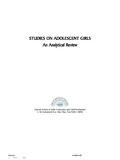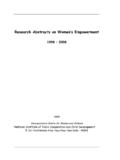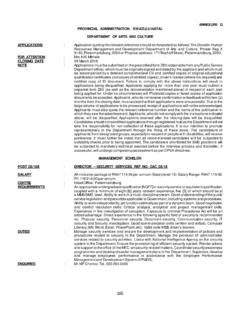Transcription of Statistics on Women in India 2010
1 Statistics on Women in India2010 National Institute of Public Cooperation and Child Development5, Siri Institutional Area, Hauz Khas, New Delhi - 110016 Number of Copies : 1000 Copyright:National Institute of Public Cooperation and Child Development, 2010 Published by:National Institute of Public Cooperation and Child Development5, Siri Institutional Area, Hauz KhasNew Delhi - 110016 Printed at:Power Printers2/8-A, Ansari Road, Darya GanjNew Delhi-110 002 Phone : 23272445, 23283911 Project TeamGuidance and Support:Dr. Sulochana VasudevanText:Meenakshi SoodHimani NautiyalComputer Assistance:Varun KumarSupport Services:H. K. Barthwal, EditingA. J. Kaul, PublishingInstitutional Cooperation:Government Ministries and DepartmentsAutonomous OrganisationsUnited Nations OrganisationsInternational OrganisationsResearch InstitutionsVoluntary OrganisationsPrefaceWomen play a pivotal role in the overall progress of a country as they constitute halfthe human resources of a nation.
2 The economic wealth of a country is seriously depletedif about half of the nation s human resource is neglected. Recognising the need for involvingwomen in various development activities, the Government of India has initiated severalaffirmative measures by way of programmes and schemes to bring them into the mainstreamof development. These affirmative actions have brought about perceptible changes in thesocio-economic conditions of Women . The literacy rate of females, which was in1951 rose to in 2001. Women s work participation rate, which was in 1981,rose to in 2001. The data base also brings out the areas where the progress hasbeen slow if not retrograde. The sex ratio in the 0-6 years age group dropped from 945 in1991 to 927 in 2001, which indicates that society still does not welcome a girl child and thepreference rests with sons.
3 Nearly 50% Women get married before they attain 18 years ofage, and pregnant Women and married Women suffer from anaemia. Maternalmortality rate (MMR) is still quite high, at 254 maternal deaths per 100,000 live births (in2006). Thus, there is room for much more to be done to ameliorate the plight of Women atthe grass root Eleventh Five-Year Plan aims to achieve inclusive growth and reduce comprehensive picture of Women and Girls in India as revealed through collected statisticswould be a useful reference base to show the progress India has achieved so far. Thisdocument is an effort to capture statistically the situation of Women and girls in India , onthe basis of many social indicators which are available in widely scattered sources. Variousindicators covered in this document are : demography and vital Statistics ; health andnutritional status; education; girl child; work participation of Women and children; supportmeasures for Women , including Women in distress; political participation of Women andwomen in decision making; prevalence of disability; crime against Women and children;food security; household expenditure; budget outlays for Women in the Union Budget andBudget of the Ministry of Women and Child Development; and voluntary organisationsinvolved in the social development document has been compiled with the efforts of a team of officers and staff of theInstitute.
4 Dr. Sulochana Vasudevan, Joint Director, Women s Development Division,provided support and guidance to a team headed by Ms. Meenakshi Sood, and comprisingMs. Himani Nautiyal, who have painstakingly compiled and updated the information andstatistics several times over. While Shri Varun Kumar provided computer assistance,Shri A. J. Kaul, Publications Officer and other officials of the Common Services Divisionwere instrumental in ensuring the timely publication of the document. I acknowledge withgratitude the contribution of various Government Departments, autonomous organisations,UN agencies, international organisations, research institutes and voluntary organisations,who extended full cooperation and shared their documents with document shows at a glance Statistics on indicators which are available in variouspublished sources.
5 We have put in the effort with the hope that this document would be auseful asset to administrators, planners, researchers, academicians, media persons, andothers concerned with issues related to Women s empowerment.(Dinesh Paul) for Women s Empowerment- Introduction1- Perspectives on Advancement of Women through Five Year Plans- International Policies and India s Constitutional Provisions, Policies and Programmes for Women - Schemes for Assistance- Policy and Vital and and Services to Women28210. Crime against Women and Children31111. Gender Development Index34012. Political Participation of Women and Women in Decision Making34313. Women and Disability36014. Household Consumer Expenditure37115. Budget Outlay384 Annexure 1 Goals to be Achieved by 2010 set by the National396 Population Policy 2000 Annexure 2 The United Nations Millennium Declaration s Goals for397 Development and Poverty Eradication till 2015 3 Definitions298 Annexure 4 Recommended Dietary Allowance (RDA) for Indians, 2009400viiviiiList of TablesTable 1 Indicators of Human Development for SAARC Countries17and Some Asian Countries, 2008 Table 2 Basic Indicators of Human Development, 1951- 200818 Table 3 Progress of Indian Women , 200819 Table 4 Population of States/Union Territories by Sex (Final),21 Percentage Share of Population in Total Population,and Decadal Growth Rate, 5 Sex Ratio in Five Year Age Groups, and Percentage23 Population in Five Year Age Groups, 2001 Table 6 Female Target Groups in Population (in millions)
6 , 200124 Table 7 Child Population 0-6 Years, 200125 Table 8 Population in Five Year Age Groups by Sex in States/Union26 Territories (Total), 2001 Table 9:Projected Population of India , States/UTs by Sex as on501st March 2007, 2010 and 2016 Table 10 Scheduled Castes (SC) Population in Five Year Age Groups51by Sex in States/Union Territories (Total), 2001 Table 11 Scheduled Tribes (ST) Population in Five Year Age Groups73by Sex in States / Union Territories (Total), 2001 Table 12 Population by Residence and Sex, and Households, India94and States/Union Territories (Final), 2001 Table 13 Population by Rural Urban Residence and Urban97 Population (%), 2001 Table 14 Birth Registration of Children under Five Years by98 State, 2006 Table 15 Urban and Slum Population in India , States/ UTs Wise, 200199 Table 16 Birth Rate, Death Rate and Natural Growth Rate, 2008100 Table 17 Infant Mortality Rate (IMR)
7 , 2008 and Child Mortality101 Rate, 2006 Table 18 Infant Mortality Rate, Sex-wise and Rural Urban103 Distribution, 2008 Table 19 Sex Ratio, Expectation of Life at Birth, Maternal Mortality104 Rate,2001-2006 Table 20 Sex Ratio of Select Countries, 1998 and 2007106 Table 21 Sex Ratio, India , 1901-2001106 Table 22 Sex Ratio of Total Population and Child Population in the107 Age Group 0-6 Years, 1991 and 2001ixxTable 23 Sex Ratio (Females per 1000 Males) and Sex Ratio Children109 Aged 0-4 Years, 2005-2007 Table 24 Percentage Distribution of Adolescent Population and109 Projected Adolescent Population by Sex and Age Group,1981-2016 Table 25 Age-specific Fertility Rates (ASFRs) in India and Bigger110 States, 2007 Table 26 Total Marital Fertility Rate (TMFR) by Residence India and111 Bigger States, 2006-07 and Mean Children Ever Born toWomen Aged 40-44 Years, 2007-08 Table 27 Death Rates of Children 0-4 Years to Total Deaths by Sex112and Residence India and Bigger States, 2007 Table 28 Distribution of Deaths to Total Deaths in India by Residence,113 Sex and Age Group (Percentage), 2007 Table 29 Maternal Deaths Due to Causes Related to Child Birth and114 Pregnancy, 2003 Table 30 Discrimination against the Girl Child, as ,1162006-2007 Table 31 Women and Men Who Want More Sons than Daughters,117(%), 2006 Table 32 Incidence of Early Marriage in India , 2007-2008 & Early120 Motherhood in India , 2001 Table 33 Number of Females by Marital Status and Residence.
8 122 India States and Union Territories - 2001 Table 34 Distribution of Female Population Age 10+ by Marital Status125and Residence in India and Bigger States, (Percentage),2007 Table 35 Female Population Age 15+ by Marital Status and126 Residence in India and Bigger States, (Percentage), 2007 Table 36 Child Labour in India , 1991 and 2000128 Table 37 Child Labour in Census, 1971-2001129 Table 38 Child Labour in Hazardous Occupations, 2001131 Table 39 Commitment to Health : Access, Services andResources, 2007132 Table 40 Urban Health Infrastructure, 2005-06133 Table 41 Rural Households without Toilet Facilities, 2001135 Table 42 Rural Habitations Having Safe Drinking Water, 2007137 Table 43 Number of Primary Health Centres (PHC), Community139 Health Centres (CHC), Doctors, Lady Health Visitors (LHVs),and Multi-Purpose Workers (Female)/ Auxiliary NurseMidwives (ANM) in Rural Areas, 2008xiTable 44 Institutional Delivery and Safe Delivery, 2007-08141 Table 45.
9 Mothers Receiving Antenatal and Post Natal Care,1432007-2008 Table 46 Decision Making by Ever Married Women Own Health Care144(Percentage), 2005-2006 Table 47 Child Immunization and Vitamin A Supplementation,1452007-2008 Table 48 Major Causes of Infant Mortality in India , 2003146 Table 49 Burden of Neonatal Deaths in India State-wise, 2002146 Table 50 Percentage Distribution of Deaths for Selected Major Cause147 Groups over Age and Sex, 2002 Table 51 Age-wise Total Deaths in India by Major Cause Group149(Percentage), 2002 Table 52 Age and Sex-Wise Total Deaths in India by Major Cause150 Group (Percentage), 2002 Table 53 Causes of Death by Major Groups State-wise and151 Sex-wise (%), 2002 Table 54 Distribution of Ten Top Killer Diseases of Infants155(Below One year) in Rural India , (%), 1998 Table 55 Child Deaths in 1-4 Years Age Group by Major Cause156 Groups Sex-wise, 2002 Table 56 Ten Top Killer Diseases of Children 1-4 Years by Specific157 Causes, 1998 Table 57 Child Deaths in 5-14 Years Age Group by Major Cause158 Groups Sex-wise, 2002 Table 58 Top 10 Causes of Death of Children in India Age below1591 Year, (%), 2001-2003 Table 59 Top 10 Causes of Death of Children in India Ages 1-4 Years,159(%), 2001-2003 Table 60 Top 10 Causes of Death of Children in India160 Ages 5 to 14 Years, (%), 2001-2003 Table 61 Top 10 Causes of Death of Children in India , EAG States160and Assam, in the Age Group 5 to 14 Years, (%), 2001-2003 Table 62 Top Ten Killer Diseases of Females in Reproductive161 Age Group 15- 44 Years in Major States/ India (%)
10 , 1998 Table 63 Ten Top Killer Diseases of Females in the Reproductive162 Age Group (15-44 years and 45-54 years), India , 2002 Table 64 Adults and Children Living with HIV/AIDS, 2003163 Table 65 AIDS Cases in India , States and UTs, 2007164 Table 66 AIDS Patients on ART, 2009165xiiTable 67 Malaria Cases in India and States/ UTs, 2007-2008166 Table 68 Nutritional Status of Women and Body Mass Index (BMI),1682006 Table 69 Rural Women (15-49 Years) with Chronic Energy Deficiency170(CED), Percentage, 2006 Table 70 Anaemia among Women and Pregnant Women ,171(Percentage), 2006 Table 71 Anaemia among Children 6-59 Months (Percentage),1722005-2006 Table 72 Children with Malnutrition/ Undernutrition under age 5 Years,173(%), 2005-2006 Table 73 The India State Hunger Index and Its Underlying174 Components, 2009 Table 74 Daily Average Intake of Energy and Proteins against175 Recommended Intake by Age/Sex/Physical Activity of RuralPopulation, 2001 Table 75 Average Intake of Energy, Proteins, Iron and Vitamin A176against the Recommended Daily Intake Allowances(RDA), 1998 Table 76 Per Capita Consumption of Various Foods Items (gms/day)176in Rural Areas, 1993-94 Table 77 State-wise Profile of Consumption of Iodized Salt, 2005-2006177 Table 78 Nutritional Status of Children 1-5 Years by Gender, Gomez178 Classification, (%), 2006 Table 79 Deficient Calorie Intake (per cu/day)








